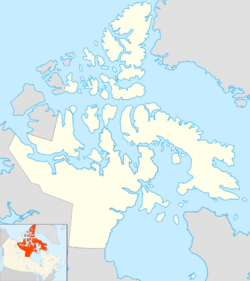Kinngarjuaq facts for kids
| Geography | |
|---|---|
| Location | Hudson Strait |
| Coordinates | 62°36′28″N 69°30′07″W / 62.60778°N 69.50194°W |
| Archipelago | Arctic Archipelago |
| Administration | |
|
Canada
|
|
| Territory | Nunavut |
| Region | Qikiqtaaluk |
| Demographics | |
| Population | Uninhabited |
Kinngarjuaq (which is ᑭᙵᕐᔪᐊᖅ in Inuktitut syllabics) is a cool island in Nunavut, Canada. It used to be known as Juet Island. This island is found in the Hudson Strait, a large body of water in the Canadian Arctic. It's also very close to Baffin Island, which is one of the biggest islands in the world.
Kinngarjuaq is an uninhabited island. This means that no people live there all the time. The closest community to Kinngarjuaq is Kimmirut. Kimmirut is a small town about 35 kilometers (or 22 miles) away.
Contents
Where is Kinngarjuaq Located?
Kinngarjuaq is part of the Qikiqtaaluk Region in Nunavut. Nunavut is a large territory in northern Canada. The island sits in the Hudson Strait, which connects the Hudson Bay to the Atlantic Ocean.
This area is part of the Arctic Archipelago. This is a huge group of islands in the Arctic Ocean. Kinngarjuaq is considered an "offshore island" of Baffin Island. This means it's a smaller island located just off the coast of the much larger Baffin Island.
Islands Nearby Kinngarjuaq
Kinngarjuaq is not alone in the Hudson Strait. Many other islands are found close by. Some of these islands include Lavoie Island, Wishart Island, and Lee Island. These islands, along with Kinngarjuaq, are part of the amazing landscape of the Canadian Arctic.
Ancient History of Kinngarjuaq
Even though Kinngarjuaq is uninhabited today, people lived there a very long time ago. Archaeologists have found important clues about these ancient people. They discovered eight different sites on the island. These sites show signs of early human activity.
Who Lived on Kinngarjuaq?
The ancient people who lived on Kinngarjuaq belonged to what archaeologists call the pre-Dorset culture and the early Dorset culture. These cultures were groups of people who lived in the Arctic thousands of years ago.
The pre-Dorset culture existed from about 2500 BC to 500 BC. The Dorset culture followed them, lasting from about 500 BC to 1500 AD. These people were skilled hunters and gatherers. They adapted to the cold Arctic environment.
What Did Archaeologists Find?
At the sites on Kinngarjuaq, archaeologists carefully dug up artifacts. These are objects that ancient people made and used. The findings help us understand how these early cultures lived. They might have found tools made of stone or bone. They could also have found evidence of their shelters or hunting practices.
These discoveries tell us a lot about the history of human life in the Arctic. They show that people have been exploring and living in these northern lands for thousands of years. Kinngarjuaq, though small and remote, holds important secrets from the past.



